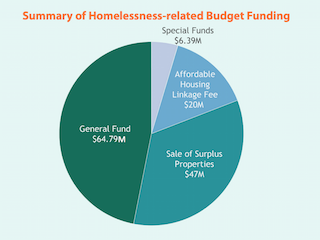Truth matters. Community matters. Your support makes both possible. LAist is one of the few places where news remains independent and free from political and corporate influence. Stand up for truth and for LAist. Make your year-end tax-deductible gift now.
This is an archival story that predates current editorial management.
This archival content was written, edited, and published prior to LAist's acquisition by its current owner, Southern California Public Radio ("SCPR"). Content, such as language choice and subject matter, in archival articles therefore may not align with SCPR's current editorial standards. To learn more about those standards and why we make this distinction, please click here.
Garcetti Proposes 'Seven-Fold' Increase In Spending To Fight Homelessness In Proposed Budget

Mayor Eric Garcetti doubled down on fighting homelessness with his proposed budget for the coming fiscal year, pledging to allocate “unprecedented resources to get Angelenos off the streets.” God knows we need them. The proposed budget, which the mayor called a “$8.76 billion blueprint for our city,” was presented Wednesday at City Hall.It includes a $138 million plan for addressing homelessness, which the mayor said would constitute a seven-fold increase from previous spending. According to the L.A. Times, the actual numbers are closer to a five-fold increase from the previous fiscal year, but who's counting. The money will be pulled from multiple sources, some of which don't currently exist (more on that later).
The mayor's homelessness strategy would address three main pillars: 1) housing those currently in need, 2) street-level engagement, and 3) prevention. The plan will be built on a “housing first” model, which is basically what it sounds like—a strategy that prioritizes getting individuals off the streets and into permanent supportive housing, above all else. Housing first models have occasionally been controversial because they don't make participation in mental health or drug recovery programs a condition for housing, but they've been incredibly successful in a number of places, including—and perhaps, most notably—the state of Utah, which saw an astonishing 91 percent reduction in chronic homelessness after housing first policies were implemented. Housing first strategies have long been considered a "best practice" in L.A., but according to Garcetti, they've never been sufficiently scaled-up to see real results.

(Graphic courtesy of the Mayor's Office)
This year’s proposed funding surge will largely come from one-time sources, which clearly isn't sustainable. The mayor stressed that new sources would have to be found for the city to continue to address homelessness. He raised the possibility of putting the decision in the voters' hands at some point through a local ballot initiative, though specifics were left, well, unspecified. He also called on City Council to introduce linkage fees, a levy on developers that would require them to set aside a certain amount of money per project to fund affordable housing in the city. Linkage fees already exist in San Francisco, San Diego, Chicago and Boston, according to the L.A. Times.It turns out that the city also has a bunch of properties around town that aren't currently in use. The mayor highlighted their role as a possible tool in his homelessness-fighting arsenal, saying they could either be used as locations for affordable housing developments, or be sold off to fund said developments.
Also, remember that time a federal judge ruled that the city couldn't just destroy homeless people's property willy-nilly, and that impounded belongings had to be kept in accessible locations? (C'mon guys, that was literally a week ago, someone must remember it.) Well, Garcetti is on it. Speaking of the undue burden that might be placed on a homeless individual living in San Pedro if his stuff was, say, stored downtown, he advocated the construction of six different storage sites around the city. Of particular interest is his proposal for the storage sites in question to be more than mere city-run closets; they would also function as "navigation centers" where basic services could be provided, and individuals could tap into social service programs.
The mayor, looking sharp in what appeared to be a light purple tie, fielded quite a few questions about just how realistic his proposal was, given that a number of his named funding sources don't actually exist, at least as of now. For example, a little more than a third ($47 million, to be exact) of the proposed $138 million is slated to come from the sale of those surplus city properties, despite them not actually having been sold yet. The homelessness-related budget breakdown also includes a $20 million slice of the pie coming from affordable housing linkage fees, which have yet to be enacted by the City Council. "This is real," Garcetti said, pointing to a large chart of the spending breakdown shown on a screen next to him. We truly hope so.
The rest of the budget largely echoed the mayor's "back to basics" agenda (i.e. boring but important), prioritizing public safety and city streets. He pledged to trim 31,000 trees ($6.5 million), repair 425,000 square feet of city sidewalks ($31 million), and put aside $150 million for street repairs, which will include the filling of 350,000 potholes. He also plans to hire and train more police and firefighters.
His proposal is now in the hands of the City Council's Budget and Finance Committee, who will review and modify it. It will come before the full City Council for a vote sometime before June 1. See y'all then.







